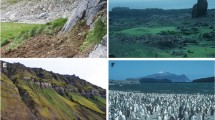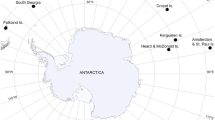Abstract
Marine environments are known to affect adjacent terrestrial biotic communities. In South America’s sub-Antarctic archipelago, birds are the most abundant and diverse terrestrial vertebrate assemblage. We hypothesized that birds would reflect a marine influence that would gradually decrease inland, expecting to find greater species richness, abundance, and biomass near the sea with decreases toward the island interior. We seasonally compared these parameters, with identified indicator species and assessed functional groups at 0, 150, and 300 m from the coast. Unexpectedly, we found a marked marine (0) and terrestrial (150–300) patterns for avian assemblages, rather than a gradient. In addition, seasonal patterns were warm (spring–summer) and cold (autumn–winter). The only parameter that displayed a true gradient was avian biomass in spring. During the cold season, higher values were observed in all variables for coastal assemblages, compared to inland sites. In the warm season, abundance and richness of coastal and terrestrial assemblages were similar, owing to migratory species. Milvago chimango was the only species abundant and frequent in both terrestrial and coastal systems, thereby indicating potential as a marine–terrestrial vector. Functionally, coastal assemblages were conformed of herbivores, carnivores, and scavengers, while terrestrial communities were made up of omnivores and insectivores. We conclude that the sea coast is a unique habitat in this archipelago, providing refuge for both marine and terrestrial sub-Antarctic birdlife particularly in the cold season. The relevance of the land/sea ecotone is poorly known, but important is given to high demand for the installation of salmon aquaculture facilities along the southern Chilean coastline.




Similar content being viewed by others
References
Anderson WB, Polis GA (1998) Marine subsidies of island communities in the Gulf of California: evidence from stable carbon and nitrogen isotopes. Oikos 81:75–80
Anderson CB, Rozzi R (2000) Bird assemblages in the southernmost forests in the world: methodological variations for determining species composition. An Inst Patagonia Ser Cien Nat 28:89–100
Anderson WB, Wait DA (2001) Subsidized island biogeography hypothesis: another new twist on an old theory. Ecol Lett 4:289–291
Anderson CB, Rozzi R, Likens GE, Gutiérrez JR, Poole AK, Armesto JJ (2008) Using long-term socio-ecological study sites to integrate research with society. Environ Ethics 30:295–312
Arroyo MTK, Riveros M, Penaloza A, Cavieres L, Faggi AM (1996) History and regional patterns of the cool temperate rainforest flora of southern South America. In: RG Lawford, Alaback P, Fuentes ER (eds) High latitude rain forest and associated ecosystems of the west coast of the Americas: climate, hydrology, ecology and conservation. Springer, Berlin.
Bancroft W, Roberts J, Garkaklis M (2005) Burrowing seabirds drive decreased diversity and structural complexity and increased productivity in insular-vegetation communities. Aust J Bot 53:231–241
Barrett K, Anderson WB, Wait DA, Grismer LL, Polis GA, Rose MD (2005) Marine subsidies alter the diet and abundance of insular and coastal lizard populations. Oikos 109:145–153
Bradley RA, Bradley DW (1993) Wintering shorebirds increase after kelp (Macrocystis) recovery. Condor 95:372–376
Camperi AR, Darrieu CA (2005) Aves del alto valle del Rio Negro, Argentina. Rev Mus Argent Cienc Nat 7:51–56
Caron CM, Paton PWC (2007) Population trends and habitat use of Harlequin Ducks in Rhode Island. J Field Ornithol 78:254–262
Catenazzi A, Donnelly MA (2007) Role of supratidal invertebrates in the decomposition of beach-cast green algae (Ulva sp.). Mar Ecol Prog Ser 349:33–42
Clarke KR (1993) Non-parametric multivariate analysis of changes in community structure. Aust J Ecol 18:117–143
Couve E, Vidal C (2000) Birds of the Beagle Channel and Cape Horn. Fantástico Sur, Punta Arenas, Chile
Darimont CT, Paquet PC, Reimchen TE (2009) Landscape heterogeneity and marine subsidy generate extensive intrapopulation niche diversity in a large terrestrial vertebrate. J Anim Ecol 78:126–133
de Magalhaes JP, Costa J, Toussaint O (2005) HAGR: the human ageing genomic resources. Nucleic Acids Res 33(Database Issue):D537–D543
Diario Electrónico de la Patagonia—Radio Polar (2008) Detienen entrega de concesiones acuícolas hasta que Magallanes defina el uso del borde costero. http://www.radiopolar.com/noticia_21425.html#. Accessed 25 June 2010
Dufrene M, Legendre P (1997) Species assemblages and indicator species: the need for a flexible asymmetrical approach. Ecol Monogr 67:345–366
Elgueta EI, Valenzuela J, Rau JR (2007) New insights into the prey spectrum of Darwin′s fox (Pseudalopex fulvipes Martin. 1837) on Chiloé Island, Chile. Mamm Biol 72:179–185
Ellis JC, Fariña JM, Witman JD (2006) Nutrient transfer from sea to land: the case of gulls and cormorants in the Gulf of Maine. J Anim Ecol 75:565–574
Forero M, Bortolotti G, Hobson K, Donazar J, Bertelloti M, Blanco G (2004) High trophic overlap within the seabird community of Argentinean Patagonia: a multiscale approach. J Anim Ecol 73:789–801
Gende SM, Edwards RT, Willson MF, Wipfli MS (2002) Pacific salmon in aquatic and terrestrial ecosystems. Bioscience 52:917–928
Granadeiro JP, Santos CD, Dias MP, Palmeirim JM (2007) Environmental factors drive habitat partitioning in birds feeding in intertidal flats: implications for conservation. Hydrobiologia 587:291–302
Harding JS, Hawke DJ, Holdaway RN, Winterbourn MJ (2004) Incorporation of marine-derived nutrients from petrel breeding colonies into stream food webs. Freshw Biol 49:576–586
Humphrey PS, Bridge D, Reynolds PW, Peterson RT (1970) Birds of Isla Grande (Tierra del Fuego). Preliminary Smithsonian Manual. Smithsonian Institution, Washington
Ibarra JT, Rozzi R, Gilabert H, Anderson CB, McGehee SM, Bonacic C (2009a) Seasonal dynamics and distribution patterns of birds associated to sub-Antarctic wetlands in the Cape Horn Biosphere Reserve (54–55 degrees S), Chile. Ornitol Neotrop 20:321–337
Ibarra JT, Fasola L, Macdonald DW, Rozzi R, Bonacic C (2009b) Invasive American mink Mustela vison in wetlands of the Cape Horn Biosphere Reserve, southern Chile: what are they eating? Oryx 43:87–90
Ibarra JT, Anderson CB, Altamirano T, Rozzi R, Bonacic C (2010) Diversity and singularity of the avifauna in the austral peat bogs of the Cape Horn Biosphere Reserve. Chile. Cienc Investig Agrar 37:29–43
Ippi S, Anderson CB, Rozzi R, Elphick C (2009) Annual variation of abundance and composition in forest bird assemblages on Navarino Island, Cape Horn Biosphere Reserve, Chile. Ornitol Neotrop 20:231–245
Jaksic FM, Feinsinger P (1991) Bird assemblages in temperate forests of North and South America: a comparison of diversity, dynamics, guild structure, and resource use. Rev Chil Hist Nat 64:491–510
Jaramillo A, Burke P, Beadle D (2005) Aves de Chile. Ingoprint SA, Barcelona
Jiménez JE (2000) Effect of sample plot size and counting time on estimates of avian diversity and abundance in a Chilean rainforest. J Field Ornithol 71:66–87
Marczak LB, Thompson RM, Richardson JS (2007) Meta-analysis: trophic level, habitat and productivity shape the food web effects of resource subsidies. Ecology 88:140–148
Martínez DE, González GE (2004) Las aves de Chile. nueva guía de campo. Ediciones del Naturalista. Imprenta Salesianos, Santiago
Naiman RJ, Décamps H (1997) The ecology of interfaces—riparian zones. Annu Rev Ecol Evol S 28:621–658
Owens IPF, Bennett PM (2000) Ecological basis of extinction risk in birds: habitat loss versus human persecution and introduced predators. PNAS 97:12144–12148
Paetzold A, Lee M, Post DM (2008) Marine resource flows to terrestrial arthropod predators on a temperate island: the role of subsidies between systems of similar productivity. Oecologia 157:653–659
Pimm S, Raven P, Peterson A, Sekercioglu CH, Ehrlich PR (2006) Human impacts on the rates of recent. present and future bird extinctions. PNAS 103:10941–10946
Pisano E (1980) Distribución y características de la vegetación del archipiélago del Cabo de Hornos. An Inst Patagonia Ser Cien Nat 11:192–224
Pizarro JC (2010) Las aves como vínculo trans-ecosistémico y trans-disciplinario: las ciencias ecológicas y las éticas ambientales en la investigación, educación y la conservación en la Reserva de Biosfera Cabo de Hornos, Chile. Master in Science Thesis, Universidad de Magallanes, Chile
Polis GA, Anderson WB, Holt RD (1997) Toward an integration of landscape and food web ecology: the dynamics of spatially subsidized food webs. Annu Rev Ecol Evol S 28:289–316
Raya Rey A, Schiavini ACM (2000) Distribution, abundance and associations of seabirds in the Beagle Channel, Tierra del Fuego, Argentina. Polar Biol 23:338–345
Remsen JV Jr, Cadena CD, Jaramillo A, Nores M, Pacheco JF, Robbins MB, Schulenberg TS, Stiles FG, Stotz DF, Zimmer KJ (2009) A classification of the bird species of South America. American Ornithologists’ Union. http://www.museum.lsu.edu/~Remsen/SACCBaseline.html. Acceded 8 Jan 2010
Rose MD, Polis GA (1998) The distribution and abundance of coyotes: the effects of allochthonous food subsidies from the sea. Ecology 79:998–1007
Rozzi R, Massardo F, Anderson CB, Berghoefer A, Mansilla A, Mansilla M, Plana J (2006) Reserva de Biosfera Cabo de Hornos. Ediciones de la Universidad de Magallanes, Punta Arenas, Chile
Sabat P, Nespolo RF, Bozinovic F (2004) Water economy of three Cinclodes (Furnariidae) species inhabiting marine and freshwater ecosystems. Rev Chil Hist Nat 77:219–225
Sanchez-Pinero F, Polis GA (2000) Bottom-up dynamics of allochthonous input: direct and indirect effects of seabirds on islands. Ecology 81:3117–3132
Schiavini ACM, Yorio P (1995) Distribution and abundance of seabird colonies in the Argentine Sector of the Beagle Channel, Tierra del Fuego. Mar Ornithol 23:39–46
Schlatter RP, Riveros GM (1997) Historia natural del archipiélago Diego Ramírez, Chile. Ser Cient INACH 47:87–112
Sekercioglu CH, Daily GL, Ehrlich PR (2004) Ecosystem consequences of bird declines. P Natl Acad Sci USA 101(52):18042–18047
Summers RW, Grieve A (1982) Diet, feeding behavior and food intake of the Upland Goose Chloephaga picta and the Ruddy-headed Goose C. rubidiceps in the Falkland Islands. J Appl Ecol 19:783–804
Tuhkanen S (1992) The climate of Tierra del Fuego from a vegetation geographical point of view and its ecoclimatic counterparts elsewhere. Acta Bot Fenn 145:1–65
Valenzuela JA (2002) Conducta territorial y alimentaria de la caranca (Cholephaga hybrida Molina. 1782) en el litoral pacífico de Chiloé insular. Ph.D. Dissertation, Universidad Austral de Chile
Van Geest GS, Hessen DO, Spierenburg Dahl-HansenGAP, Christensen G, Faerovig PJ et al (2007) Goose-mediated nutrient enrichment and planktonic grazer control in arctic freshwater ponds. Oecologia 153:653–662
Venegas C (1981) Aves de las islas Wollaston y Bayly, Archipielago del Cabo de Hornos. An Inst Patagonia Ser Cien Nat 12:213–219
Venegas C (1994) Aves de Magallanes. Ediciones de la Universidad de Magallanes, Punta Arenas, Chile
Venegas C, Sielfeld W (1998) Catálogo de los vertebrados de la región de Magallanes y Antártica chilena. Ediciones Universidad de Magallanes, Punta Arenas
Wiens JA, Stralberg D, Jongsomijit D, Howell CA, Snyder MA (2009) Niches, models, and climate change: assessing the assumptions and uncertainties. PNAS 106:19729–19736
Winder M, Schindler DE, Moore JW, Johnson SP, Palen WJ (2005) Do bears facilitate transfer of salmon resources to aquatic macroinvertebrates? Can J Fish Aquat Sci 62:2285–2293
Acknowledgments
We are grateful for the participation and support of numerous people in the design, collection and analysis of these data, especially the volunteers, staff and directors of the sub-Antarctic Biocultural Conservation Program (Universidad de Magallanes, Institute of Ecology and Biodiversity and University of North Texas). JCP acknowledges his master’s scholarship from the Institute of Ecology and Biodiversity and CONICYT through the Basal Financing Program (PFB-23) and the Millennium Scientific Initiative (P05-002) and the Rufford Small Grant Foundation, which helped finance the research as part of the project entitled Omora Bird Observatory: Long-Term Ornithological Studies and Conservation in the Cape Horn Biosphere Reserve, Chile (RSG 20.08.08). Birder’s Exchange also donated field equipment. This publication is a contribution to the Omora Ethnobotanical Park, which is a long-term socio-ecological research site (http://www.ieb-chile.cl/ltser) in the Cape Horn Biosphere Reserve.
Author information
Authors and Affiliations
Corresponding author
Electronic supplementary material
Below is the link to the electronic supplementary material.
Rights and permissions
About this article
Cite this article
Pizarro, J.C., Anderson, C.B. & Rozzi, R. Birds as marine–terrestrial linkages in sub-polar archipelagic systems: avian community composition, function and seasonal dynamics in the Cape Horn Biosphere Reserve (54–55°S), Chile. Polar Biol 35, 39–51 (2012). https://doi.org/10.1007/s00300-011-1029-7
Received:
Revised:
Accepted:
Published:
Issue Date:
DOI: https://doi.org/10.1007/s00300-011-1029-7




